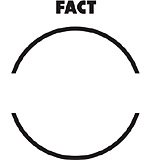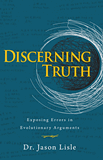Missing? or Misinterpreted?
Originally published in Creation 26, no 2 (March 2004): 22-25.
‘Facts’ by themselves are essentially meaningless—they all need to be interpreted within a particular philosophical framework.
Have you ever watched the comedy movie The Gods Must Be Crazy? Someone drops a coke bottle from a plane into a group of native people in Africa who have never seen such a bottle. The whole movie centres around a particular interpretation of what they thought the coke bottle really was. The movie title refers to their belief that “the gods” had sent it. However, it caused so many squabbles about who should use it that they decided that it was an evil thing that must be returned to the gods by dropping it over “the edge of the world.”
The bushmen had a totally different way of looking at this bottle from that of the people who dropped it. Why did they get it so wrong? The following exercise will help us understand what was happening.
Consider the following “fact.” Observe it very closely.

Now attempt to answer this question about the fact. What do you think this most likely was originally? What do you think is most likely missing?

Let me help you by offering you some options. See if one of these is one of the possibilities you thought of.

Most people say it was a circle originally, and thus choose option E. However, the correct answer is that nothing is missing, because I drew the “fact” (first illustration pictured above) just as you see it!
This simple exercise teaches us a very important lesson about evidence and interpretation. The point is that “facts” by themselves are essentially meaningless—they all need to be interpreted within a particular philosophical framework.
Let’s consider our “fact” above. I asked a question: “What is missing?” By doing this I gave people a particular presupposition to use when looking at this fact. If someone accepts this presupposition that something is missing, then they look at the fact believing they have to come up with a solution as to what is missing. Thus, the person is now looking at the fact in a particular way—with a specific belief about the “fact” that they have accepted. When people say it was a circle, they have actually interpreted the fact in a particular way, consistent with their way of thinking that is based on the presupposition stating something is missing.

Now the circle interpretation is totally consistent with the person’s way of thinking and is totally consistent with their presupposition—it’s just the interpretation is totally wrong because they started with the wrong presupposition.
What those listening to me should have done was to question my question! In other words, instead of accepting this presupposition without question, they should have asked how I knew something was missing—thus questioning my question! In doing so, a person may then discover that there could be a totally different way of looking at this same “fact.”
The problem is that most people have not been trained to even understand that every “fact” has been interpreted by a presupposition that in essence asks a question—let alone whether the right question was asked!
For instance, the public reads almost daily in newspapers and magazines that scientists have dated a particular rock at billions of years old. Most just accept this. However, creation scientists have learned to ask questions as to how this date was obtained: What method was used? What assumptions were accepted to develop this method?
These scientists then question those assumptions (questions) to see whether they are valid or not and determine whether the rock’s age could be interpreted differently. Then the results are published to help people understand that scientists have not proved the rock is billions of years old, and that the evidence can be interpreted in a different way to support a young age.
For example, consider the research from the creationist RATE group concerning the age of zircon crystals in granite. Using one set of assumptions, these crystals could be interpreted to be around 1.5 billion years old, based on the amount of lead produced from the decay of uranium (which also produces helium). However, if one questions these assumptions, one is motivated to test them. Measurements of the rate at which helium is able to “leak out” of these crystals indicate that if they were much older than about 6,000 years, they would have nowhere near the amount of helium still left in them. Hence the originally applied assumption of a constant decay rate is flawed; one must assume, instead, that there has been acceleration of the decay rate in the past. Using this revised assumption, the same uranium-lead data can now be interpreted to also give an age of less than 6,000 years.1
The bushmen in the movie had the wrong presupposition when trying to interpret the coke bottle. Because they asked the wrong question, they came up with the wrong answer and thought it was something that was evil and must be disposed of.
All of this should be a lesson for us to take note of the situation when we read the newspaper—we are reading someone’s interpretation of the facts of world history—there very well could be a different way of looking at the same “facts.” One can see this in practice on US television when comparing a news network that’s currently considered fairly liberal (CNN) with one that is more conservative (FOX)—one can often see the same “facts” interpreted differently!
I had the opportunity to explain all of this to a student at a Christian university who was frustrated with one of her professors who claimed to believe the Bible was the Word of God.
She said: “I wanted to write a paper on Job 40, stating my belief that the creature called ‘behemoth’ mentioned in this passage was a dinosaur living at the time of Job. However, my professor told me that unless I could show clearly documented evidence that dinosaur and human fossils were found together in the same rock layers—and he said no one has ever found this—then, I could not write on dinosaurs and humans living together. He said that scientists had proved dinosaurs lived millions of years before man. What can I say to my professor?”
My response was to suggest this student confront her professor with two issues:
-
If the Bible really is the Word of God, who knows everything, and is the true record of history (which it is), then all of our thinking must start with God’s Word.
The Bible clearly teaches that God created everything in six literal days.2,3,4 On Day Six, God made land animals (which must have included dinosaurs, as they were land animals) and Adam and Eve.
Therefore, on the basis of God’s authority, we should be prepared to say that dinosaurs and humans lived together, regardless of what the world claims.
Now, since God’s Word in Genesis is true history, then any evidence, properly interpreted on this basis, will be consistent with observational science. Whereas if the evidence is interpreted on the basis of the professor’s view, that dinosaurs lived millions of years before man, it should ultimately conflict with observational science and thus show a problem with the interpretation.
-
I told this student to use the coelacanth fish (pictured right) to explain a very important point to her professor. For a long time, this fish was believed to have evolved about 340 million years ago and become extinct about 70 million years ago—about the same final extinction “date” claimed for the dinosaurs. This was because fossils of coelacanth fish are found in rocks the same evolutionary age as the dinosaurs, but not rocks “dated” younger. So coelacanths were believed to have died out long before man came on the scene, and thus never lived at the same time as people. However, in 1938, scientists found live coelacanths were being caught off the coast of Madagascar.5 Decades later, researchers found that Indonesian fisherman had also been selling coelacanths in their fish markets for years.6
Now here’s the point. No fossils of coelacanths have ever been found in the same layers as human fossils, but they have been found in the same layers as dinosaur fossils—yet we know coelacanths and humans do live together, because they do so in the present world.
In other words, just because we don’t find fossils of certain creatures (or plants) together with humans in the fossil record, it doesn’t mean they didn’t live together.
Starting with the Bible, and therefore the presupposition that man and dinosaur did live together, we can properly interpret such “facts” (or in this case, really the absence of a fact—thus an argument from silence). But, as our coelacanth example shows, the absence of human fossils in “dinosaur rock” does not support the presupposition that dinosaurs lived millions of years before man.

The famous Wollemi pine from Australia—yet another living example of something previously known from fossils only, and dated by evolutionists as existing millions of years ago. Creationists understand that the reason no evolutionary change is evident in the many living fossils, like this one discovered, is that there has been no evolution.
And it’s not just the coelacanth—there are numerous (in fact hundreds) of examples of plants and animals living today that are represented in the fossil record as being supposedly millions of years old, and yet they are not found fossilized in the same layer as human fossils. Consider the Wollemi pine tree found in 1994 in the Blue Mountains in Australia—it was thought to have become extinct with the dinosaurs, but was then found living alongside people in this present world!7 Another example is the tadpole shrimp, said to have lived from 250 to 65 million years ago, yet identical shrimps have been found living today.8
The reason so many Christian professors (and Christian leaders in general) have rejected the literal creation position is that they have blindly accepted the interpretation of evidence from the secular world, based on man’s fallible presuppositions about history. So they have tried to reinterpret the Bible accordingly.
If only they would start with the presupposition that God’s Word is true. They would find that they could then correctly interpret the evidence of the present, and also show overwhelmingly that observational science over and over again confirms such interpretations. For example, fossil red blood cells and traces of hemoglobin have been found in T. rex bones, although they should have long decomposed if they were millions of years old.9 Yet the reaction of the evolutionary researchers was a perfect illustration of how evolutionary bias can result in trying to explain away hard facts to fit the preconceived framework of millions of years:
It was exactly like looking at a slice of modern bone. But, of course, I couldn’t believe it. I said to the lab technician: “The bones, after all, are 65 million years old. How could blood cells survive that long?”10
Whenever you hear a news report that scientists have found another “missing link” or discovered a fossil “millions of years old’—try to think about the right questions that need to be asked to question the questions these scientists asked to get their interpretations!
And don’t forget, as Christians, we need to always build our thinking on the Word of the One who has the answers to all of the questions that could ever be asked—the infinite Creator God. He has revealed the true history of the universe in His Word to enable us to develop the right way of thinking about the present and thus determine the correct interpretations of the evidence of the present. We should follow Proverbs 1:7 and 9:10 that teach that fear of the Lord is the beginning of true wisdom and knowledge.
Footnotes
- Humphreys, D.R., Austin, S.A., Baumgardner, J.R. and Snelling, A.A., Helium diffusion rates support accelerated nuclear decay; in: Ivey, R.L. Jr., Proceedings of the 5th International Conference on Creationism, Creation Science Fellowship, Pennsylvania, USA, pp. 127–142, 2003; www.globalflood.org/papers/2003ICChelium.html.
- Stambaugh, J., The Days of Creation: A Semantic Approach, TJ 5(1):70–78, 1991.
- Grigg, R., How long were the days of Genesis 1?, Creation19(1):23–25, 1996. This is largely based on Stambaugh, The Days of Creation: A Semantic Approach
- Steinmann, A., אחד [echad] as an ordinal number and the meaning of Genesis 1:5, JETS 45(4):577–584, December 2002.
- Catchpoole, D., “Living fossils” enigma, Creation 22(2):56, 2000.
- More “living fossil” coelacanths, Creation 23(2):5, 2001.
- ‘Dinosaur Tree’ Behind Bars, Creation 23(3):56, 2001.
- Scheven, J. and Wieland, C., “Ghostly Shrimp Challenges Evolution!” Creation 16(3):51, 1994.
- Wieland, C., Sensational dinosaur blood report! Creation 19(4):42–43, 1997.
- Schweitzer, M., Montana State University Museum of the Rockies; cited on p. 160 of Morell, V., Dino DNA: The hunt and the hype, Science 261(5118):160–162, July 9, 1993.
Recommended Resources

Answers in Genesis is an apologetics ministry, dedicated to helping Christians defend their faith and proclaim the good news of Jesus Christ.
- Customer Service 800.778.3390
- © 2024 Answers in Genesis



